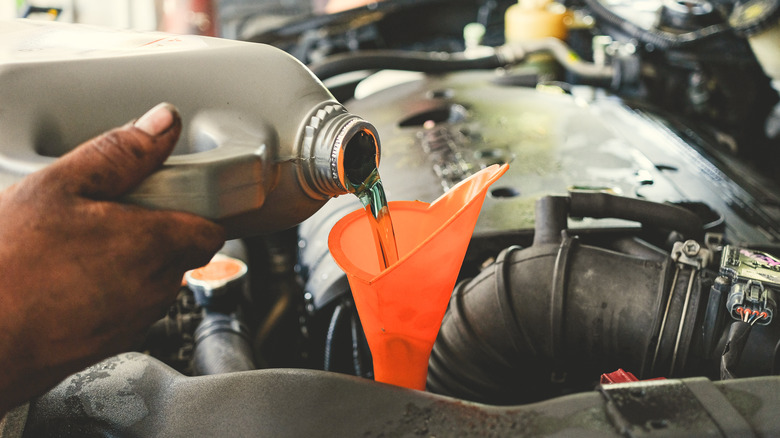
Ivan-balvan/Getty Images
We may receive a commission on purchases made from links.
You don’t need to be a professional mechanic to change your vehicle’s transmission fluid, but you will need the right tools. There are some hacky suggestions out there, like dipping toilet paper into the reservoir to soak up the old fluid before pouring in the new, but they are definitely not recommended. It turns out, this isn’t exactly the best method, since the tubes can still retain much of the dirty old fluid.
To perform a proper renewal of your vehicle’s transmission fluid, you’ll need to put together a few more tools and know-how than just a roll of toilet paper. Choosing the appropriate transmission fluid comes first, while a drain pan, car jack or ramp, new pan gasket, and a couple of other things will prove highly useful. It’s also a good idea to use this opportunity to change the transmission filter, so we recommended grabbing one of those as well. That’s the short list of what you’ll need.
In this guide, we’ll explain how to choose the correct products to prepare in advance for a transmission fluid change. We’ll start with the bare necessity, the fluid itself, and then dive into the suggested tools that will help.
The essential: Choosing your transmission fluid

Iamskylineex/Getty Images
It’s super important to choose the right transmission fluid, since it lubricates the entire transmission system. Without appropriate lubrication, metal-on-metal contact can quickly wear down parts. Such damage can result in warning signs that your transmission is going bad.
To find the right type of fluid for your vehicle, check your owner’s manual. There are several types, with Dextron and Mercon being the main choices. Certain vehicles are only compatible with a specific type, and your owner’s manual should specify which is compatible or incompatible. If you don’t have your manual or can’t find the info, search the web for your specific vehicle’s make and model to find out.
For those with manual transmissions, the owner’s manual will probably indicate that automatic transmission fluid (ATF) can still be used in your manual vehicle. Only certain, older vehicle models are incompatible with ATF. Furthermore, vehicles with continuously variable transmissions (CVT) may require their own specific fluid. Moreover, cars with dual-clutch transmissions (DCT) may also call for a specific fluid. If you don’t have the owner’s manual, make sure to look up the right type online.
There are also quality considerations. Transmission fluid comes in two main forms: synthetic and conventional. You should almost always go with synthetic. It’s more expensive but delivers a longer-lasting and superior performance. That being said, conventional fluid is sometimes the better choice for antique cars. If your vehicle is older than about 50 years, you should look up whether conventional fluid is the preferred option.
Finally, you’ll have to pick a brand. The top-ranked brands of transmission fluid include Valvoline, Royal Purple, Red Line, Amsoil, and Pentosin. As long as the above requisites (type and quality) are met, you can choose a brand based on your budget and preferences.
The recommended: Tools that will help greatly

Andresr/Getty Images
In any guide to changing the transmission fluid, you’ll likely come across steps that involve lifting the vehicle, draining the fluid into a pan, and some that mention tools you might not have. Even simply diagnosing common transmission problems requires a few handy tools. Let’s go over these recommended, nonmandatory materials.
It’s a good idea to lift your car up onto jacks or a ramp before getting to work. Your manual may mention a specific lift point or angle, since this will help shift the old fluid so that it drains fully. If your manual doesn’t specify, you can search your vehicle’s make and model to find out the ideal lift point.
Thus, a car jack or ramp is recommended for changing your transmission fluid. For those who don’t have one, you can try driving onto a hill, curb, or incline to achieve the desired lift point. In this case, you can break out the level.
Next, a drain pan will help greatly. When you release the gasket, old fluid will drain out in a messy flow. Drain pans specifically designed to catch this outflow aren’t too expensive. This is also the point where you can swap out the filter. If you’re unsure of what transmission filter to buy, bring the old one into the store or ask an employee to check your vehicle while it’s in the parking lot.
Finally, for a thorough flush, you can pick up a fluid pump system to make sure every last drop is removed. Whether you go for the flush or the pump, you should grab a rag to wipe up any dirty fluid that escapes the pan.